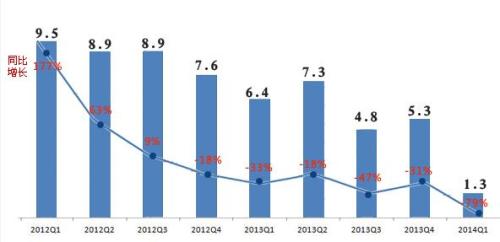 Dell announced its financial report for the first quarter of fiscal year 2014 early this morning. Earlier, Dell plans to publish earnings reports in advance. The move sparked investor suspicion: investors fear that this may mean that Dell's performance in the first quarter was very poor.
Dell announced its financial report for the first quarter of fiscal year 2014 early this morning. Earlier, Dell plans to publish earnings reports in advance. The move sparked investor suspicion: investors fear that this may mean that Dell's performance in the first quarter was very poor. Sure enough, Dell’s answer to this question was not satisfactory: revenue was US$14.074 billion, a year-on-year drop of 2%; net profit was US$130 million, a 79% year-on-year drop.
What caused the dramatic decline in Dell's net profit? Let's look at the following sets of data:
Corporate solutions revenue of 3.1 billion US dollars, an increase of 10%; operating profit of 136 million US dollars, an increase of 71%;
Service revenue was 2.1 billion U.S. dollars, up 2% year-on-year; operating profit was 370 million U.S. dollars, up 10% year-on-year;
User terminal revenue was US$8.9 billion, down 9% year-on-year; operating profit was US$224 million, down 65% year-on-year;
Software revenue was 295 million U.S. dollars, compared with 38 million U.S. dollars in the same period of last year; operating losses were 85 million U.S. dollars and the figure was 6 million U.S. dollars in the same period last year.
From this we can see that Dell's revenue and net profit have fallen in a double-deal, the fundamental reason is the sluggish sales of traditional PCs. In response, Dell CFO Brian Gladden said: “In the first quarter, we made progress in developing enterprise solutions business. We have taken steps in key business areas, especially end-user computing. Strengthen our competitiveness. This affects the profitability."
In April of this year, a report released by IDC, a market research organization, showed that in the first quarter of 2013, global PC shipments were 76.3 million units, a 13.9% decrease from the same period of last year, far exceeding the agency’s previous forecast of 7.7%. The PC industry experienced a year-on-year decline in shipments for the fourth consecutive quarter. It also set a record for the year-on-year decline since 1994. At the same time, IDC expects Dell's PC sales in the first quarter will be reduced by 11% over the same period last year.
“Although the economic situation has improved slightly, new computers equipped with Windows 8 systems have been available, but PC shipments worldwide have remained significantly lower than a year ago,†IDC said in a report. "The shipment of small notebooks, the main product of the low-end market, has gradually shrunk, while tablet PCs and smartphones continue to divide consumer spending."
IDC also pointed out that the Windows 8 system failed to arouse users' desire to purchase. In addition, IDC also pointed out that the Windows 8 system failed to arouse users' desire to purchase. In addition, although the industry has attracted users with new features such as touch screens and ultra-thin, the lack of price thresholds and component supply have evaded corporate efforts.
Currently, the Dell Board of Directors believes that the privatization plan proposed by Dell and his allies is the safest solution for the company's shareholders, as more and more consumers and businesses are now replacing laptops and desktops with smartphones and tablets. PCs, PC sales have been steadily declining. Dell's poor performance this quarter provided substantive evidence to support the board's decent privatization program.
The pin refers to the connection between the internal circuit of the integrated circuit (chip) and the peripheral circuit, and the pin constitutes the interface of the chip. According to the function, the pins of AT89S52 can be divided into four categories: main power supply, external crystal oscillator or oscillator, multi-function I/O port, and control, strobe and reset.
Terminal Pins,Terminal Hardware Pin,High Precision Terminal Pins,Terminal Pins For Pcb
Sichuan Xinlian electronic science and technology Company , https://www.sztmlchs.com